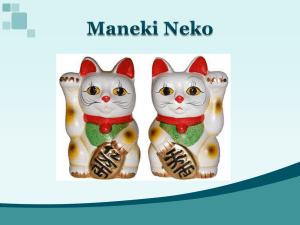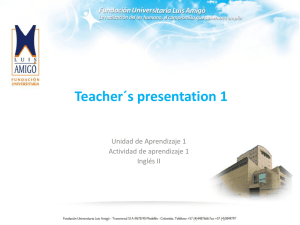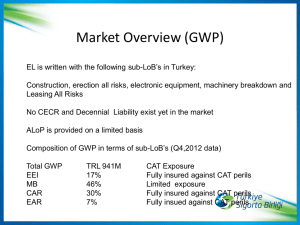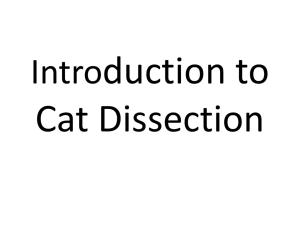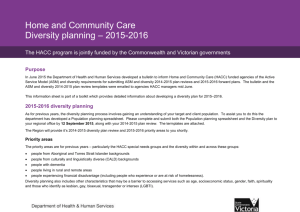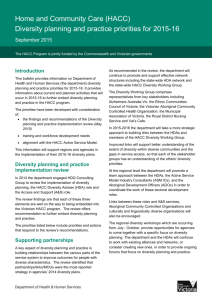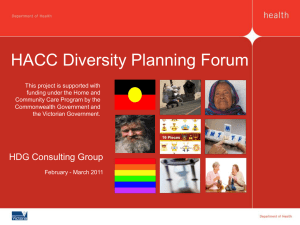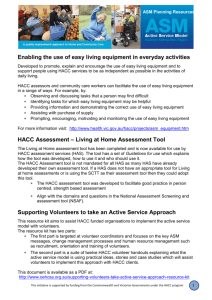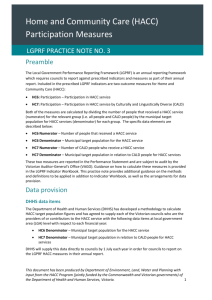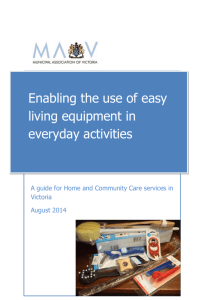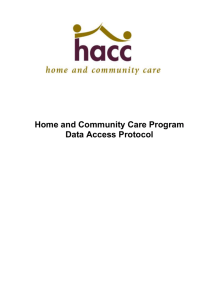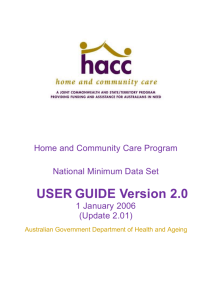Unit Cost
advertisement
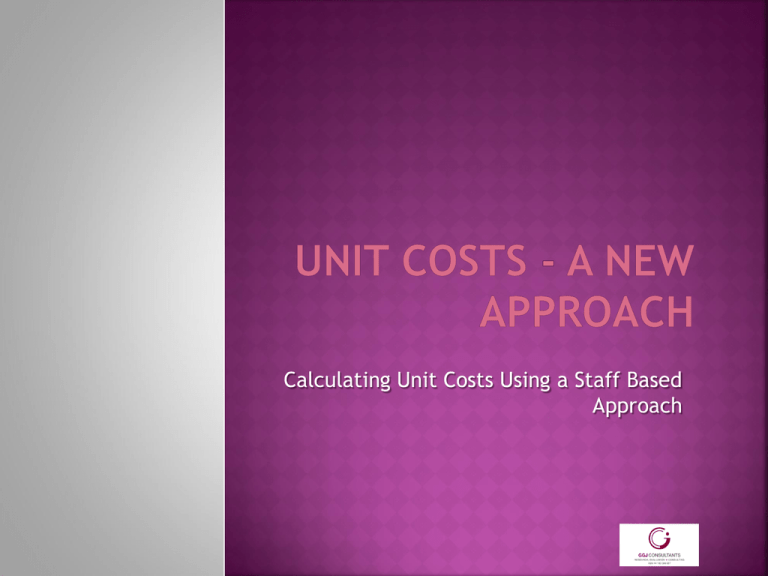
Calculating Unit Costs Using a Staff Based Approach Facilitator: Leslie Gevers Participant Introductions Housekeeping: Toilets, Phones Morning Tea Break 10.15 Your financial statements for the last year (2009-10) Information on gross wages for key staff groups or positions (e.g. Support Workers, Assessment Officer/s, Manager, Bookkeeper, etc.) Your HACC Service Specification for 2009–10 which contains your contracted outputs Your MDS reported outputs for the same period You also need a good understanding of the proportion of staff time spent across the four Unit Costs categories of: Direct work (delivering services) Direct travel (travel to deliver services) Indirect work (backup work to service delivery eg rosters, training, progress notes) Management and administration (management, accounting, quality, reception). Participants: Understand Unit Costs Understand the value of calculating Unit Costs Understand the different elements of a Unit Cost Are aware of changes they need to make in their service to effectively calculate Unit Costs Know how to use the Unit Costs Staff Based Spreadsheet Have commenced the calculation of the Unit Costs for their service. The cost of delivering one unit of service At its most simple – Unit Cost = total $ spent (HACC Annual Funding Level (AFL) + fee income + other HACC related income) divided by the delivered units E.g. if we spend $70,000 of funding plus fee income of $15,000 plus interest of $5,000 to deliver 3,000 hours of personal care the Unit Cost is $30.00 OPTIONS – reduce the costs of delivering services and increase the outputs being delivered – consider if other services can deliver for a lower Unit Cost Unit Price – funding divided by contracted units E.g. $70,000/3,000 = $23.33 Gain an understanding of the actual costs of providing HACC services Assess which service areas are most cost effective Identify ways of improving the cost effectiveness of all service areas Identify the impact of different variables affecting services such as geographical area, client group, size of services Assess fees to be charged Provide an overview of how the service is operating Establish benchmarks or targets Assess the effect of changes to services (e.g. does the new roster system result in lower unit costs?) Decide which areas of service delivery provide the most value for money to clients What is a reasonable Unit Cost for: Domestic Assistance Personal Care Social Support Day Centre Transport - small bus based Having a single Unit Cost figure (as in our example) does not provide adequate information for understanding why a Unit Cost may be high and how it can be reduced The HACC Unit Cost Model is based on 9 elements or components called Categories DIRECT COSTS Cat 1 Direct employee costs Cat 2 Direct travel Cat 3 Materials Cat 4 Direct Purchased Services INDIRECT COSTS Cat 5 Indirect time costs Cat 6 Management & admin employee costs Cat 7 Accommodation Cat 8 Other service costs Cat 9 Overhead allocation Definitions are included in the Cost Cats tab of the spreadsheet A new Unit Costs Spreadsheet has been developed to make it easier for services who have a lack of financial management support or other difficulties in using the current Spreadsheet The new spreadsheet is based on the allocation of staff hours across the following categories for each service type: Cat 1 Direct employee costs Cat 2 Direct travel Cat 5 Indirect time costs Cat 6 Management & admin employee costs Wages are then automatically allocated on the basis of hours and other Costs can also be allocated in the same way The Unit Costs Guide presents information on Unit Costs and instructions on using the Unit Costs Spreadsheet Break followed by work on the Unit Costs Staff Based Spreadsheet 1. 2. 3. 4. 5. 6. Open the spreadsheet and your Guide Rename the spreadsheet using Save As Enable macros (see Next Slide) Enter your information working progressively through the Services sheet, the Hours sheet and the Costs sheet Save regularly Copy to your USB stick at the end of the session HINT: Use the ORANGE column on the Costs sheet to automatically distribute costs across the different service types based on the proportion of wages costs for each service type Click on Circle (LH top corner) Excel Options (in bottom bar) Trust Centre Trust Centre Settings Macro Settings Enable all macros OK OK Save the Spreadsheet and close it Re-open it Things to check – on the Summary Sheet: Reasonableness of the Unit Cost If high - check the information you have entered Are service delivery and other staff fully engaged? Do schedules maximise staff time? Are staff hours appropriate to the service provision? Look at the component parts – these will indicate where expenditure may be too high – consider the % of each component – what are reasonable percentages Send your Unit Costs Summary Sheet to your HACC Project Officer REMINDER: Unit Costs are to be provided to HACC at the end of each financial year If you want to know more about us visit our web site: WWW.GGJ.COM.AU


